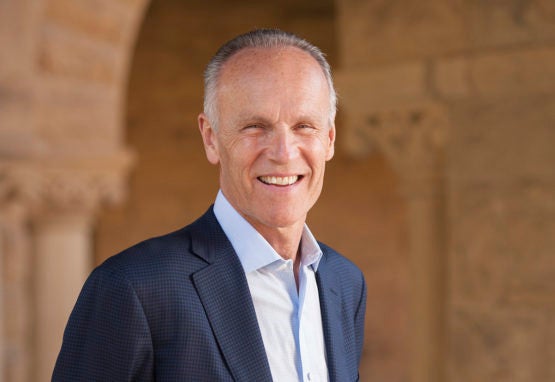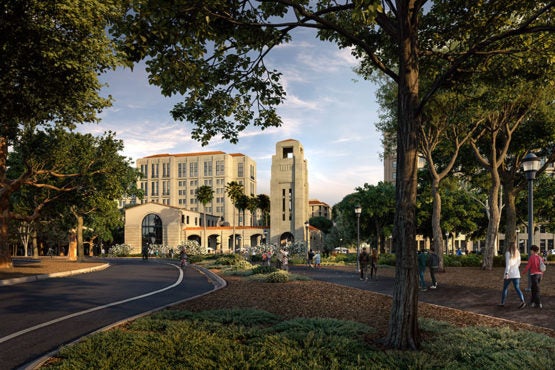Stanford trustees approve budget and construction projects and honor departing members
The June 14-15 meeting of the Stanford University Board of Trustees was the final one as chair for Steven A. Denning, who has presided as chair since July 2012.
At its recent meeting, the Stanford University Board of Trustees approved the university’s 2017-18 Budget Plan, approved new and ongoing capital projects, met with university leaders and honored departing trustees Brook H. Byers and Susan R. McCaw.
The meeting was the final one as chair for Steven A. Denning, who has served on the Board of Trustees since 2004 and has presided as chair since July 2012.

June’s Board of Trustees meeting was the last one as chair for Steve Denning. (Image credit: L.A. Cicero)
The Board of Trustees had asked Denning to extend his second two-year term by one year so he could lead the transition to the new team of President Marc Tessier-Lavigne and Provost Persis Drell. In recent months, Denning has worked with Trustee Jeff Raikes, who will become chair of the Board of Trustees on July 1, to ensure a smooth transition.
Asked what he will miss most about serving as chair, Denning said “the people,” including trustees, who are drawn together by a deep love and commitment to Stanford, as well as faculty, administrators, students and staff.
“I’ll miss the interaction with the best faculty in the world, the best administration, staff and students,” he said. “Excellence permeates every aspect of Stanford.”
Denning, who has watched many long-term projects come to life during his tenure as chair, including the arts district, Stanford at Redwood City and new student residences, also witnessed the creation of the Knight-Hennessy Scholars program. Stanford raised $750 million in seven months for the program, which will fund graduate study for students from around the world.
“The great thing about Stanford is you’re not creating energy, you’re shaping energy,” Denning said. “You’ve got people that are highly motivated across all aspects of the university – faculty, staff, alumni, administration. Everybody is aspiring to have a greater impact. It’s just a matter of shaping that energy so you can have the greatest impact you can, given the resources you have.”
2017-18 Budget Plan approved
During the June 14-15 meeting, trustees approved Stanford’s $6.3 billion budget for 2017-18. The budget anticipates a 5 percent increase in revenue, with an ending surplus of $165 million. The Budget Plan includes a $1.2 billion capital budget, which is part of a rolling, multi-year capital plan that includes projects in progress or expected to begin over a three-year period. Denning said the $4.3 billion capital plan is the largest in Stanford’s history.
“Almost half of that capital plan is for housing, and a large chunk of that is for graduate housing,” Denning said, noting that Stanford has begun preparing the site and demolishing existing buildings to make way for Escondido Village Graduate Residences, one of several construction projects underway on the east side of campus.

Among the projects reviewed by the trustees at their June meeting was the Escondido Village Graduate Residences. (Image credit: Rendering courtesy Korth Sunseri Hagey Architects)
Denning said next year’s budget reflects Stanford’s strong commitment to undergraduate financial aid, with a 4.3 percent increase in financial aid slated for next year.
Denning said Tessier-Lavigne discussed his recent visits to Washington, D.C., where he addressed the importance of federal funding for research universities.
“We’re maintaining a real vigilance in that regard,” Denning said. “There will be continued pressure in that federal domain and I think it’s incumbent on Stanford and other major research universities to make it very clear how important federally funded research has been and is to the underlying economic prosperity of the country and the richness we have as a society. We need to make certain the case is fully understood so it’s not inappropriately and mistakenly cut or reduced in any dramatic fashion.”
Trustees hear from university leaders
As part of its continuing review of the schools and major campus entities in preparation for Stanford’s long-range planning process, the trustees heard presentations on Stanford Medicine, the Hoover Institution and Stanford Management Company. Denning described the discussions as extensive and informative.
Prior to the meeting, trustees received eight white papers regarding Stanford Medicine. During the meeting Lloyd B. Minor, dean of the Stanford School of Medicine and professor of otolaryngology, and Randy Livingston, chief financial officer of Stanford, led a discussion of the white papers. Christopher G. Dawes, president and chief executive officer of Lucile Packard Children’s Hospital and David Entwistle, president and CEO of Stanford Health Care, were present and answered questions. Trustees also heard a presentation by Robert Wallace, chief executive officer of the Stanford Management Company, which invests and manages the university’s endowment and other financial assets, and a presentation by Thomas Gilligan, who became director of the Hoover Institution in September 2015.
Departing trustees praised
Trustees held a dinner to recognize the service of two members whose terms ended earlier this year: Brook H. Byers, who served five years, and Susan R. McCaw, who served 10 years. Denning described them as “two fabulous trustees” whose legacies will be enduring.
Denning said Byers, a noted life sciences investor and a partner at Kleiner Perkins Caufield & Byers, played a key role in the health care and medical field.
“Brook used his expertise and his experience to help the university in a variety of ways,” Denning said, noting that two centers on campus bear his name in honor of his support and generosity: the Stanford Byers Center for Biodesign and the Byers Eye Institute.
Denning said McCaw, who was a strong advocate of increasing financial aid for international students, created a scholarship for international students with her husband, Craig. McCaw served on the presidential search committee that chose Tessier-Lavigne as Stanford’s 11th president, a responsibility Denning described as one of the board’s most important tasks.
“Susan was also an advocate and supporter of the Knight-Hennessy Scholars program,” Denning said. “She was active in the development and design of the program and she continues her involvement as a member of the program’s global advisory board.”
Construction projects
The Board of Trustees gave concept and site approval to three new projects: a housing and commercial complex in Menlo Park; eight single-family detached homes on campus; and an Emergency Operations Center & Electronic Communications Hub.
Middle Plaza in Menlo Park
Trustees gave concept, site and land-use approval for a mixed-use project in Menlo Park, including a residential complex that would provide 215 rental apartments – one- and two-bedroom units – for Stanford faculty and staff. The complex, which will be located along El Camino Real, will include private interior courtyards, a fitness center and a swimming pool. Parking for residents and visitors will be located primarily underground.
Trustees also gave land-use approval for three commercial buildings – office and retail spaces – the university plans to build on the eight-acre site. Parking will be located primarily underground and will be separate from the residential parking structure. Stanford will tear down the existing buildings – all former auto dealerships – to make way for the residential and commercial buildings. The mixed-use project is expected to return to the Board of Trustees in October 2017 for design approval.
Cabrillo-Dolores Faculty Homes
Trustees gave concept and site approval to a proposal to expand Stanford’s housing stock by tearing down two existing unoccupied homes on campus and replacing them with eight single-family detached homes. To help meet the needs of faculty for affordable, high-quality housing, Stanford will use restricted ground leases to offer some of the homes at purchase prices that are below the nearby markets.
Each of the homes will include at least three bedrooms, a two-car garage and a private study. The homes will vary in size from approximately 2,500 to 3,200 square feet. The homes will have differing plans and architectural styles, in keeping with the existing homes in the eclectic neighborhood. The site lies just above Mayfield Row on the edge of the historical San Juan Hill neighborhood, across Dolores Street from the “hill lots” subdivision created in a similar redevelopment project in 1998.
The project is expected to return to the Board of Trustees for design approval in October 2017.
Emergency Operations Center & Electronic Communications Hub
Trustees gave concept and site approval for an Emergency Operations Center (EOC) and Electronic Communications Hub (ECH) Building in the Bonair Corporation Yard.
The proposed two-story building will be located at the future intersection of Bonair Siding Road and Pampas Lane, next to the new Public Safety Building. The building’s primary entrance will be located on an entry plaza along Bonair Siding Road that is being designed in conjunction with the new Public Safety Building.
The new building will replace two existing electronic communications hubs and the space currently used by the EOC in the Faculty Club. The space in the Faculty Club, which takes four hours to set up, does not meet current seismic requirements and is too small to accommodate the EOC when it is fully activated. Stanford activated the EOC in an emergency drill last November.
The project is expected to return to trustees for both design and construction approval in October 2017.
Other construction projects
Trustees gave construction approval to Denning House, the future home of the Knight-Hennessy Scholars Program. Stanford held a ground-breaking ceremony on May 1 for the building, which will have classrooms, meeting, lecture and discussion rooms, and a dining space for regular dinners and events.
Trustees also gave construction approval to a plan to renovate and revitalize Frost Amphitheater, a tree-lined bowl located in the university’s arts district that is prized by the Stanford community and the Bay Area public for performances and events.
In addition, trustees gave design approval to four projects: the Public Safety Building; the expansion of the Environmental Health and Safety Facility; the Center for Academic Medicine; and a new Children’s Center of the Stanford Community.
